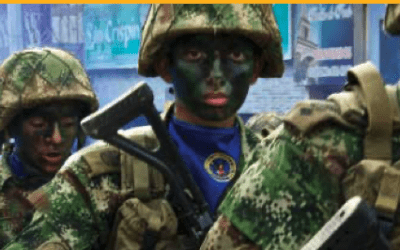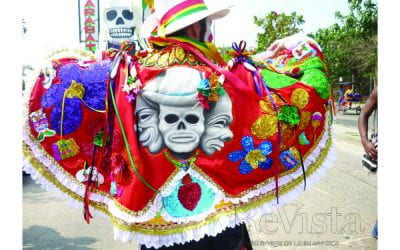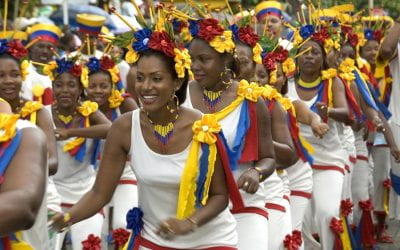Proud to be Bolivian
Visibility Fights Xenophobia in Buenos Aires

Leading the Bolivian parade on Buenos Aires’ Avenue 9 de Julio before an enthusiastic crowd. Photo by Marcelo Alvarez Ascarrunz.
There was a time in Buenos Aires when Bolivians were often victims of hate crimes. They huddled in their working-class neighborhoods, hoping they might be confused with others from Argentina’s north. Those times are changing, and fiestas—as well as legal reforms—have helped make the Bolivian community visible in a positive way. In 2010, for instance, hundreds of Bolivians migrants and their Argentine-born children marched during the bicentennial “Parade of Collectivities,” occupying a more central space in comparison with other more “traditional’’ immigrant communities like the Italians. Since 2009, Bolivians even have their own folkloric parade at the microcentro of Buenos Aires.
When you hear “Buenos Aires,” the first thing you may think of is a couple dancing tango accompanied by a violin orbandoneón, symbols of the transoceanic immigration that at the beginning of the 20th century left its mark on both urban landscapes and local culture. It is enough just to walk down Avenue 9 de Julio or through the Plaza de Mayo and observe the still-existent architecture from that period to feel as if one is in Europe—not a coincidence if we consider the process by which the Argentine nation-state was constructed. Under the slogan “Civilization or Barbarism” (in which the former is white-European-desirable and the latter is indigenous-mestizo-backwards), the Argentine government attempted to “modernize” the population, which correlated perfectly with policies meant to encourage foreign immigration, beginning in 1880. These policies resulted in the formation of the famous crisol de razas or melting pot, which, despite being diverse, excluded large segments of society. The so-called “little black headed-ones” (that is to say, the migrants from other provinces—especially those from Argentina’s north) mingled with people from neighboring countries in their own neighborhoods on the margins of the city. If they were even to consider walking through the exclusive Recoleta neighborhood or through Plaza de Mayo among the city’s resident porteños, they would be completely out of their element. Unless of course it was to participate in one of the large political demonstrations of Juan Domingo Perón’s first government (1945-1955), when these cabecitas negras became the focus of the alleged benefactor state that brought them there. And even then they were looked down upon and criticized by elites and the middle classes.
However, during that same period, migrants from bordering countries such as Bolivia were going where few could see them: to the sugarcane and grape harvests and to the cotton fields on the Bolivian-Argentine border. Many even traveled between the three harvests, loading their aguayos (blankets) with basic supplies and also with their icons of the Virgin and the saints. Being so far from the center of the country (Buenos Aires), they were not seen as a “social problem.” Crises of the regional economies—principally of the sugarcane harvests when drought struck—provoked the migration of many workers, including Bolivians, to the larger cities. By the 1960s and 70s, when Bolivian migrants moved to Buenos Aires, they became more visible to porteño eyes.
Some of these first Bolivian families settled at the southern end of the city, for instance in the Charrúa neighborhood, then known as Villa Piolín (“string village”) because residents marked the boundaries of their properties with cord. These families not only survived three large fires (which threatened the great number of houses made of flimsy cardboard) but also resisted attempts by successive military governments to evict them. Up until fairly recently, the eradication of “temporary” settlements such as Charrúa was a government policy objective. During the same struggle, in the 1970s, a migrant from the Cochabamba department in Bolivia brought a statue of the Virgin of Copacabana to the heart of the neighborhood where a chapel now stands. Around 1973, families and neighborhood residents organized themselves to celebrate the first novena (nine days of communal prayer) dedicated to the Virgin. They decided to name a pasante or ritual sponsor, design typical clothes, convoke a band and prepare typical foods at the first procession in honor of the mamita de Cochabamba, Patroness of Bolivia and of Bolivians abroad. A few dancers and some guitarists accompanied the religious procession, but there were no more than 300 people from the first families whose practice of Andean solidarity allowed them to form the neighborhood which would become a referent for many other communities and migrants.
It was in 1991 that Argentina implemented the so-called Convertibility Plan, an exchange policy that established a fixed exchange rate between the Argentine peso and the U.S. dollar. Initially, this generated an economic stability and growth that caused many Bolivians to emigrate to Argentina and particularly to its capital. However, at mid-decade, when economic growth reached its limit and unemployment rose to 20%, migrants from neighboring countries and especially Bolivians—who had survived “camouflaged” within an important marginal working class—became more visible. Sustained by an immigration policy inherited from military dictatorships based on restrictions, selection and control of migratory flows, the government of President Carlos S. Menem decided to implement sanctions and persecute “illegals.” Among migrants from countries on Argentina’s borders, Bolivians—whether documented or undocumented—suffered acutely due to the racist component of this stigmatization. Primarily from the Andean region (including various rural and indigenous communities), Bolivians faced very high levels of xenophobic violence. In the media they were accused of delinquency, narcotrafficking and the breakdown of security. Many Argentines spoke of a “silent invasion,” blaming Bolivians for the collapse of public services such as hospitals and schools. Around this time, several Bolivian citizens were murdered, with their deaths linked to police abuse including torture and robbery, crimes that are still unpunished. In fact, to this very day, even though there has been some positive change, a large sector of porteño society still makes Bolivians scapegoats for Argentina’s social problems.
Faced with these attacks, Bolivians mobilized toward the end of the 90s and began to demand justice, even calling on the international community for support. They organized in defense of their rights and actively participated in the creation of the current Argentine Migration Law, which is a global vanguard. The law not only demands respect for the basic human rights of migrants, but also establishes terms of equality between natives and foreigners, especially for those who come from other South American countries. Bolivians began to win access to “central” spaces in which visibility could mean something positive and reinforcing. These spaces allowed them to recount their histories from their own points of view and express their own cultures, customs and convictions beyond their neighborhoods. Although the change has not occurred without conflict, conquering these spaces has meant winning a symbolic battle against the negative stereotypes that sustained the stigmas that had branded them in the 90s and before. Whether in the Flores cemetery on the Day of the Dead, when Bolivians bring offerings and remember their dead with music, or in the Indoamericano or Avellaneda parks where they play soccer and enjoy typical foods, Bolivians today constitute one of the large groups recognized as part of Argentina’s contemporary crisol de razas.
This citywide growth of cultural spaces paralleled that of their own neighborhoods, as in Charrúa, where the celebration expanded from one lone group dancing to more than one hundred groups now found nationwide. Some of these groups have more than 500 dancers. Many are Bolivians, who dance out of nostalgia to remember their country, but an increasing number of second-generation Argentine-Bolivians participate for the enjoyment of affinity and communitarian spirit. These groups perform many types of typical Bolivian dances: caporal, morenadas, tinku, saya, salaque, diablada, kullawada and pujllay, dances with distinct territorial origins that contribute to an understanding of Bolivia’s great cultural diversity. The Argentine society—accustomed to viewing Bolivians as a monolithic group of construction workers, domestic servants or small-scale food vendors—is often completely unaware of that diversity.
This emphasis on pluri-cultural patrimony also promotes identity rights, the right to be who you are without fear of being repressed or excluded, the right to have rights. In addition to the Migration Law, another new government policy establishes a better orientation. The Secretary of National Culture (an entity that answers directly to the Presidency and has funded the folkloric parade which, for the last four years, has proceeded down the central Avenue 9 de Julio) declared, “One sees the way the Bolivians participate and integrate, and thinks, ‘If the great challenge of Argentina at its Centenary was to integrate the European migration, which it did, then the great challenge of the Bicentenary is to integrate the Latin American and Bolivian migration, [and] of course to remind ourselves of our true South American belonging’” (http://www.youtube.com/watch?v=wlIg5PVLcEg).
Over the past ten years, these migrants—now, after Paraguay’s, making up the second most important percentage of Argentina’s resident foreign population—have started to win in the war of invisibility, overcoming attempts to negate, annul or hide them, to make them little more than urban poor, to strip them of their identity, customs, traditions and specificity as a people, to treat them just as cheap labor force. This victory has made them visible in a positive way and allowed them to speak out with their own voice. Taking into account that more than half of Bolivians in Argentina live in Buenos Aires and its surrounding areas, to see this group of men and women, most with indigenous features and of Andean heritage, celebrate their heritage at the capital’s center demonstrates some of the cultural and political change. That their culture parades down Avenue 9 de Julio, past the iconic obelisk, through Plaza de Mayo and by the national cathedral and Presidential Palace (Casa Rosada), in front of thousands of astonished porteños and tourists who still sometimes ignore and stigmatize them, allows us to think that it is possible to break negative stereotypes by a show of positive characteristics. It is possible to overcome the ignorance of others (whether local or not), recuperate an ignored cultural heritage, creatively fight against xenophobia and convert victimhood into pride. As a result, Bolivians have indeed taken a step toward revindicating the rights that correspond to migrants as human beings, regardless of nationality, age, gender, race or wherever they decide to live their lives.
The authors wish to acknowledge and thank Alicia Carmona for the accurate translation of this article, which included some important clarifications of specific terms based on her extended knowledge of Bolivian culture and immigration in Buenos Aires.
Spring 2014, Volume XIII, Number 3
Natalia Gavazzo is an assistant professor and researcher at CONICET (the Argentine Council for Scientific and Technological Investigations of the San Martín National University (IDAES-UNSAM). Since 1999, she researched immigration in the countries bordering on Argentina, as well as in Europe, the United States, and other Latin American countries and has published widely on the topic. A frequent consultant on immigration issues for both national and international organizations, she holds a doctorate in anthropology (FFyL–UBA) and a Master’s in Latin American Studies (University of London).
Consuelo Tapia is a development specialist and researches immigration policy, cultural patrimony and policy management, and labor inclusiveness, with a focus on gender and multicultural participation. She has consulted extensively with several United Nations programs and is currently the Project Coordinator for the Organization of Ibero-American States (OEI).
Related Articles
Festival and Massacre
Festivals are privileged spaces to help us understand the meaning of community. They are a special way of presenting historical narratives, bringing…
Fiesta and Identity
English + Español
In Barranquilla the days of Carnival begin early. From the first hours of the day—already confused with the last hours of the night—the smells of celebration are in the air. The streets…
Fiestas: Editor’s Letter
At the Oruro Carnival, a few hours from La Paz, the heavy-set blue-skirted women swirl past me in a dizzying burst of color and enviable grace. The trumpeters, some with exotically dyed hair, blare not too far behind. I remember that as a young man President Evo Morales had been a trumpeter in this very carnival.




